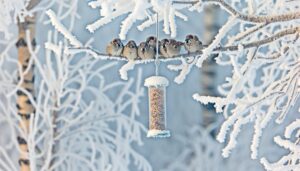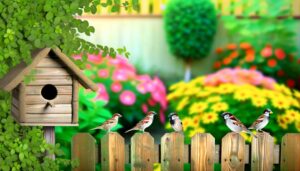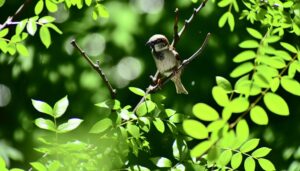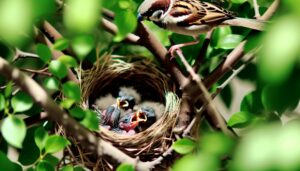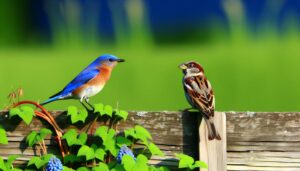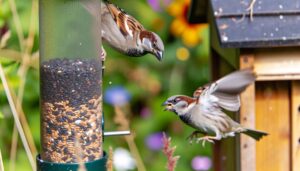Observing Foraging Behavior of House Sparrows in Urban Areas
House Sparrows (Passer domesticus) exhibit extraordinary adaptability in urban settings through varied foraging behaviors. They mainly employ ground pecking and opportunistic scavenging, often consuming human food leftovers, bird feeder provisions, and natural food sources.
Their foraging behavior experiences seasonal changes to optimize resource availability. These birds play a significant role in urban ecosystems, impacting species interactions and ecological equilibrium.
The sparrows' dietary flexibility and multiple yearly reproductions guarantee ongoing utilization of urban resources. Further investigation will unveil how these behaviors influence urban wildlife dynamics and the management strategies crucial for coexistence.
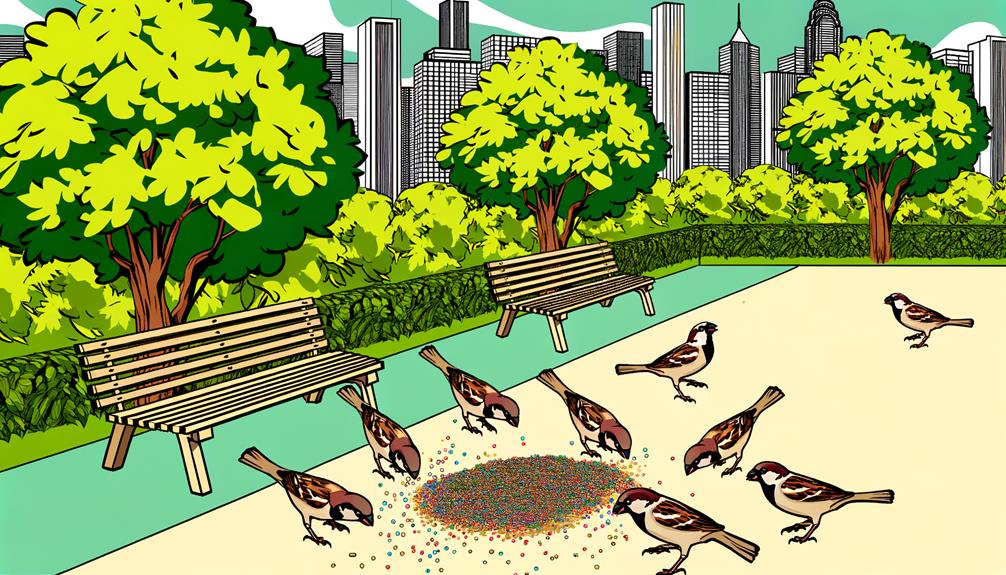
Key Takeaways
- House Sparrows employ ground pecking and opportunistic scavenging to find food in urban areas.
- They frequently consume human food scraps, making them adaptable to urban environments.
- Seasonal changes influence their foraging behavior, with different strategies employed across seasons.
- Bird feeders in urban areas provide a reliable food source for House Sparrows.
- Their foraging activities impact urban ecosystems and interactions with other species.
Adaptation to Urban Environments
House Sparrows (Passer domesticus) have developed a range of behavioral and physiological adaptations that enable them to thrive in urban environments. These small, resilient birds exhibit notable flexibility in nesting sites, utilizing man-made structures such as buildings, streetlights, and signs, which mimic their natural nesting habitats.
Their social behavior has also evolved, with increased tolerance to human activity and noise, reducing stress and enhancing survival rates. Physiologically, House Sparrows show remarkable dietary flexibility, enabling them to exploit diverse food resources found in urban settings.
Additionally, their ability to reproduce multiple times a year aligns with the continuous food availability in cities. These adaptations collectively confer a competitive advantage, facilitating their widespread presence and success in metropolitan areas.
Common Food Sources
In urban areas, house sparrows exhibit a diverse array of foraging behaviors aligned with the availability of various food sources. Key components of their diet include human food scraps, which are readily accessible in densely populated settings, as well as natural forage options such as seeds and insects found in green spaces.
Additionally, house sparrows show a marked preference for bird feeders, which provide a consistent and reliable food supply.
Human Food Scraps
Urban environments provide house sparrows with abundant human food scraps, which serve as a significant and easily accessible food source. These scraps typically include bread, fast food remnants, and various processed foods discarded by humans.
House sparrows exhibit opportunistic foraging behavior, scavenging from public spaces such as parks, sidewalks, and outdoor dining areas. The high caloric content and ease of availability of these scraps enable sparrows to meet their energy requirements efficiently. Additionally, the anthropogenic food sources reduce the time and energy spent on foraging, potentially increasing reproductive success.
However, such reliance on processed foods may lead to nutritional imbalances, impacting their health and longevity. Understanding these dynamics is important for evaluating urban ecological impacts on avian species.
Natural Forage Options
Despite the abundance of human food scraps, house sparrows also rely on a variety of natural forage options, including seeds, insects, and plant material, to supplement their diet in urban environments.
Seeds from grasses and weeds, such as dandelions and chickweed, provide necessary nutrients. Insects, particularly during the breeding season, offer a rich protein source essential for chick development. Commonly consumed insects include aphids, caterpillars, and beetles.
Additionally, plant materials such as buds, leaves, and fruits contribute vitamins and minerals. These natural food sources are crucial for maintaining nutritional balance and supporting the health and reproductive success of house sparrows amidst the challenges of urban living.
This dietary flexibility underscores their adaptability to diverse urban ecosystems.
Bird Feeder Preferences
House sparrows exhibit distinct preferences for certain types of food commonly found in bird feeders. These preferences complement their natural foraging habits and contribute to their dietary diversity in urban environments.
These birds show a marked preference for seeds, particularly millet, sunflower seeds, and cracked corn. These seeds provide essential nutrients like carbohydrates and proteins. Additionally, suet and peanut butter attract sparrows due to their high-fat content, essential for energy.
Observational studies indicate that house sparrows prioritize feeders offering a variety of these food sources. This suggests a strategy to maximize nutritional intake.
This preference underscores the adaptability of house sparrows to urban settings. In these settings, bird feeders serve as reliable, supplementary food sources amid fluctuating natural forage availability.
Foraging Techniques
Frequently employing a combination of ground pecking and opportunistic scavenging, house sparrows exhibit a range of foraging techniques adapted to urban environments. Ground pecking involves rapid, repetitive movements to capture small insects, seeds, and crumbs directly from the ground.
Opportunistic scavenging, on the other hand, allows sparrows to exploit human-derived food sources, such as discarded bread or fast food remnants. This dual strategy maximizes their access to diverse and abundant food supplies in urban settings.
Additionally, house sparrows are known to forage in flocks, enhancing their efficiency by increasing the likelihood of locating food and reducing individual vigilance. These foraging adaptations highlight the sparrow's ability to thrive in anthropogenic landscapes.
Seasonal Variations
Seasonal variations greatly influence the foraging behavior of house sparrows in urban areas, affecting both the availability of food resources and the strategies employed to obtain them.
During winter, reduced insect populations compel sparrows to rely more on anthropogenic food sources. Conversely, spring and summer bring an abundance of insects and seeds, altering their foraging patterns.
Key seasonal influences include:
- Temperature changes: Affect insect activity and availability.
- Daylight duration: Influences feeding times and energy expenditure.
- Vegetation cycles: Dictate availability of plant-based food.
- Human activity patterns: Alter waste generation and feeding opportunities.
- Migration periods: Affect population density and competition for resources.
Understanding these seasonal impacts is essential for comprehending the adaptive foraging strategies of urban house sparrows.
Impact on Urban Ecosystems
The foraging behavior of house sparrows in urban areas not only reflects their adaptive strategies to seasonal variations but also greatly impacts urban ecosystems by influencing species interactions, food web dynamics, and nutrient cycling.
By exploiting diverse food sources, house sparrows can alter the availability of resources for other urban species, potentially leading to competitive exclusion or niche displacement. Their foraging activities contribute to the redistribution of nutrients, affecting soil quality and plant growth.
Additionally, house sparrows can serve as prey for urban predators, thereby integrating into the urban food web and affecting predator-prey relationships. Understanding these dynamics is essential for urban ecological management and for predicting the cascading effects on urban biodiversity and ecosystem functionality.
Future of Urban Wildlife
The future of urban wildlife hinges on their ability to adapt to increasingly anthropogenic landscapes, necessitating a nuanced understanding of species-specific behavioral flexibility.
Effective coexistence with humans will require strategic conservation efforts and rigorous management practices to mitigate habitat fragmentation and resource competition.
Addressing these challenges is critical for sustaining biodiversity and maintaining ecological balance in urban environments.
Adapting to Urbanization
In response to increasing urbanization, House Sparrows have exhibited notable behavioral adaptations that facilitate their survival and reproductive success in densely populated human environments. These adaptations are pivotal for their persistence in areas where natural habitats are scarce and competition for resources is intense.
Key behavioral modifications include:
- Diet Diversification: Utilizing a broader range of food sources, including human-provided items.
- Nest Site Selection: Preferring nesting sites in buildings and man-made structures.
- Altered Foraging Patterns: Adjusting foraging times to avoid peak human activity.
- Increased Tolerance to Noise: Desensitization to urban noise pollution.
- Social Behavior Changes: Enhanced social learning to exploit new opportunities.
These strategies underscore the sparrows' resilience and capacity to thrive despite the challenges posed by urban environments.
Coexisting With Humans
Understanding the dynamics of coexistence between urban wildlife and human populations is essential for developing sustainable strategies that guarantee the welfare of both parties in increasingly urbanized landscapes.
House sparrows (Passer domesticus) serve as a prime example, exploiting anthropogenic resources such as food waste and artificial nesting sites. Their adaptability underscores the need for urban planning that accommodates ecological niches for wildlife while mitigating human-wildlife conflicts.
Observations indicate that sparrows adjust their foraging patterns in response to human activity, suggesting a mutual influence on behavior.
Future research should focus on the impact of urban infrastructure on sparrow populations, emphasizing the importance of green spaces and biodiversity-friendly practices to foster harmonious coexistence.
Conservation and Management
Recognizing the critical role urban environments play in the survival of house sparrows requires targeted conservation and management strategies to guarantee their sustainable populations within city landscapes. Effective approaches must be holistic, addressing key challenges these birds face.
- Habitat creation: Establishing green spaces and nesting sites.
- Pollution reduction: Minimizing air and noise pollution which adversely impact foraging efficiency.
- Food availability: Ensuring a consistent supply of natural food sources.
- Public education: Raising awareness about the ecological importance of house sparrows.
- Research and monitoring: Conducting ongoing studies to adapt and refine conservation efforts.
Through these all-encompassing strategies, urban planners and wildlife conservationists can foster environments where house sparrows and other urban wildlife can thrive.
Conclusion
The foraging behavior of house sparrows in urban areas demonstrates remarkable adaptability, drawing on diverse common food sources and employing various foraging techniques.
These behaviors fluctuate seasonally, reflecting environmental changes and resource availability. Such adaptability profoundly impacts urban ecosystems, often tipping the scales in favor of these avian inhabitants.
Understanding these dynamics is pivotal for predicting the future of urban wildlife, highlighting the intricate balance between human development and natural ecosystems.

